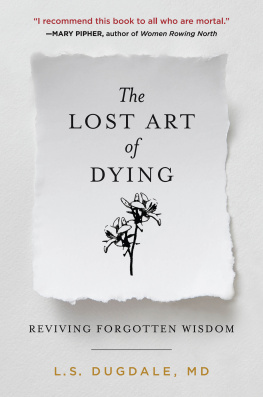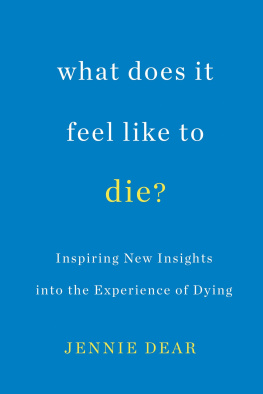THE WAY WE DIE NOW
Seamus OMahony
www.headofzeus.com

Seamus OMahonys thoughtful, moving and unforgettable book on the Western way of death shows how we have done our best to banish all thought of dying and made a good death increasingly difficult to achieve.
Today it is likely that we will die in a busy hospital in the care of strangers. We may not even know that we are dying victims of the kindly lie that there is still hope. In our final hours, we will probably be robbed of our dignity after a long series of excessive and hopeless medical procedures.
Seamus OMahony describes how difficult it is to tell the truth to patients and to their relatives who may want to believe that the inevitable can be prevented or delayed. He writes sceptically about the memoirs by and about dying celebrities such as Christopher Hitchens, Susan Sontag, Josephine Hart and Nuala OFaolain.
OMahony argues that modern medicine and society at large have conspired to sanitize death, and that this has led to bizarre modern fantasies about immortality and a self-defeating obsession with controlling the timing and manner of our death, with advance directives and assisted suicide.
We must accept, he suggests, that we are mortal animals, dependent on others, impotent in the face of nature. We need to cultivate a different attitude to death, one that acknowledges our frailty and vulnerability at the end of our days.
This book is dedicated to the memory of Dean Denis OConnor (19222013) and Tom Watret (19382013)
Contents
Death, for most people, is a rumour; something that happens to others, far away. But it is the last thing you will do or which will happen to you and the likelihood is that it will take place in an acute hospital or a care home, orchestrated by strangers. You will have little say in its pace or its manner. There is a risk that, during the course of your dying, you will be subjected to procedures and treatments that are painful, degrading and ultimately futile. If you are old, your children may make all the major decisions for you. Death may creep up on you without warning, without a chance for you to prepare yourself and settle your affairs.
Few books, as R. D. Laing remarked, are forgivable. Most of what I read about death and dying bears little relation to what I see every day in my work on the hospital wards. Doctors and nurses rarely write about death; those who do are generally palliative care (hospice) specialists, and have a particular perspective on the subject, one that I do not completely share. The language used about death and dying tends to have a quality of cloying earnestness: nobody dies anymore; they pass over, they pass on, or they simply pass. The book I wanted to read about death and dying didnt exist.
Doctors who work in large, acute-care hospitals see death differently to doctors working in the hushed and serene environs of a hospice. And yet most dying still takes place in this kind of hospital, rather than in the hospices. Half a million people die every year in England. A study of deaths in England between 2005 and 2007 found that 58 per cent of all deaths occurred in hospital, 16 per cent in nursing homes, 19 per cent at home and only 5 per cent in hospices. The Irish figures are broadly similar: 48 per cent in hospital, 4 per cent in hospices. The agonizing decisions about whether to continue aggressive medical treatment of dying patients are taken by doctors like me. By the time the hospice doctors become involved, much of the heavy lifting has been done. The conversation about death and dying needs to be reclaimed: death is too important to be left to the death specialists.
No doubt a palliative care physician would have written a different book, but their patients are, if I may use the term, more packaged. I deal with death in many guises: from the rapid and messy death in the emergency department resuscitation room, to the slow, painful death from liver disease on the general ward, to the high-tech, digital death in the Intensive Care Unit (ICU). I am witness to the sudden deceleration in medical intensity, when we abruptly shift from full intervention to the side-room, the syringe-driver (which delivers a steady dose of morphine and sedative into the blood stream) and the chaplaincy service. The deaths I see are frequently undignified; the dying very often have not accepted or understood their situation, the truth denied them by well-intentioned relatives and doctors. Their death has been stolen from them.
But this is not a medical treatise. My interest may have been kindled by professional issues, but my scope is broader than that. My interest is as much personal as professional. Like most people, I am frightened of death and medicine, apparently, attracts people with high personal anxieties about dying. The decline in religious belief in the West has exacerbated this fear. And, like many, I am haunted by a suspicion that our age, for all its technological and social progress, is one of spiritual poverty. We have paid a high price for our modern comforts.
This book has modest ambitions and is the product of my own experiences, reading and (I dare say) prejudices. Although I am Irish by birth, and work in Ireland, I am not writing specifically about death and dying in Ireland. Whilst every country has its own legal and cultural microclimate, what I have to say applies, I hope, to developed countries in general. I do, however, deal with some specifically British controversies, namely, the Stafford scandal and the Liverpool Care Pathway, because their stories tell us much about modern death and dying.
I will try to explain why modern acute hospitals make a good death increasingly difficult, and will contrast the experience in the general hospitals with that in hospices. I will examine the historical and societal factors which led to the hidden death, and why we are so fearful of honesty in our dealings with death and the dying what the late Kieran Sweeney called a hesitation to be brave. I believe that much of modern medicine is characterized by a culture of excess and dishonesty, and this culture ill-serves the dying.
I will examine contemporary ideas about death from cancer by looking at the stories of Christopher Hitchens, Susan Sontag, Josephine Hart and Nuala OFaolain. I will show how modern medicine and society at large have conspired to banish death from our consciousness, or at least to sanitize it, and how this has led to bizarre modern fantasies about immortality. I hope to persuade you that our obsession with controlling the timing and manner of our death, with advance directives and legally sanctioned assisted suicide, is ultimately self-defeating. I had previously assumed that a philosophical attitude helped people die better, but found that this assumption did not bear close scrutiny. This is not a book of consolation: death is simply affliction and the end of our days. We are frail and vulnerable animals.

What Do I Know?
We used to have a common script for dying. The great French historian Philippe Aris coined the term tame death to describe the way people died in Europe during the thousand years before the Industrial Revolution. Death was feared and regarded as a blow to the community, but the dying and their attendants knew how to do it. Death was familiar, death was swift, death was acknowledged and death was public. When death was no longer tame, when it became hidden and medicalized, we found ourselves lost and disorientated, without a script to follow. We have banished death so comprehensively from our thoughts that one of the most famous artworks of the last twenty-five years, Damien Hirsts shark-in-a-tank-of-formaldehyde, is pithily entitled The Physical Impossibility of Death in the Mind of Someone Living. This is a modern take on Freuds aphorism: It is indeed impossible to imagine our own death; and whenever we attempt to do so, we can perceive that we are in fact still present as spectators.














